|
|
|
 |
|
|
|
|
|
|
|
Apton Road
|
|
|
|
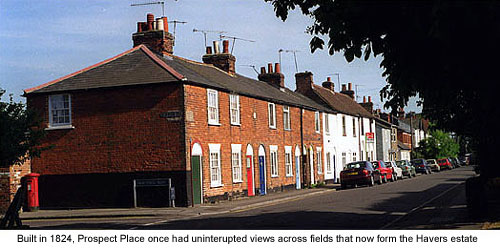 |
|
|
|
In the 17th century this road was known as Usher’s Lane, named after John Usher who owned a house at its junction with South Street. The house later became the Grapes public house (See Guide 15) and the lane was renamed Apton Fields before being re-designated Apton Road in 1880.
In 1851 a gardener and beer seller named Thomas Witham kept a beerhouse in Apton Road, which was possibly the former Royal Oak. This pub was owned in 1897 by William Hart and his wife, who regularly organised the annual New Town Fair – a social event for locals that included competitions and games. Three generations of the Hart family ran the Royal Oak for 75 years and Oak Street, opposite, took its name from it. After closure in 1992 the pub was converted into a private residence in 1996
At the junction with Newtown Road is Prospect Place, a terrace of small, red-bricked houses built in 1824 that once enjoyed seclusion and views across open fields. From this point the road descends towards the town, the relatively new housing development of Vicarage Close built on the site of the former Vicarage to Holy Trinity Church.
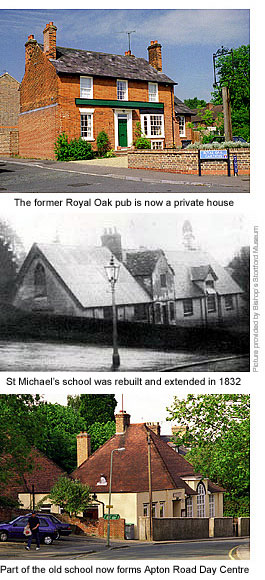 Opposite is St Michael’s Junior School, built in the 1950s and taking its name from the original St Michael's school erected in 1818. Part of that school, rebuilt and extended in 1832, now forms the Apton Road Day Centre. Opposite is St Michael’s Junior School, built in the 1950s and taking its name from the original St Michael's school erected in 1818. Part of that school, rebuilt and extended in 1832, now forms the Apton Road Day Centre.
In the early years of the 19th century, two national religious societies were formed for the purpose of bringing the rudiments of education to poor children (See Guide 7 - Northgate School). St Michael’s school was founded by the National Society to provide the principles of the Church of England and, understandably, was named after the parish church.
It was the first school in the town to cater for poor children and provided separate classes for boys, girls and infants. There can be little doubt it benefited, to some extent, from Margaret Dane’s benevolent fund (See Guide 4 - Margaret Dane). For those who subscribed to the school in the early years, girl pupils did plain sewing for them at low prices as part of their education. The school also housed a Soup Kitchen, supplying nourishment for the not so well off members of the community, and at a cost of one penny provided pupils with large jugs in which to take soup home to their parents.
The most notable, and commended, headmaster of the Boys school was Henry Frith. Taking on the job in 1860, aged 20, he stayed for 24 years.
The two modern houses (Nos 20 & 22) alongside the Day Centre are built on land that previously formed part of St Michael’s churchyard, when its southern boundary was Apton Road. By Act of Parliament in 1855, no further burials were allowed in many parish churchyards, including St Michael's, but when the wife of Rev Francis Rhodes died in 1873 her wish to be buried in a ‘distant corner’ of this churchyard, along with two of her seven sons who died in infanthood, is said to have been fulfilled. A plaque inside the church does commemorate them, but whether or not the story is true is open to debate. The point is, the ‘distant corner’ refered to is said to form part of the rear gardens of these two houses. (See Guide 4 - The Churchyard)
Land that was originally part of the Church Street vicarage garden is present day Apton Road car park, but in 1851 was the site of a garden nursery owned by Joseph Tucker. Supplying a wide variety of trees and shrubs to local houses, vicarages, farms and gentlemen, his clients included Rev Rhodes, who bought many such plants to refurbish the garden of his home at that time, Thorley Bourne (See Guide 13).
|
|
|
|
Portland Road
|
|
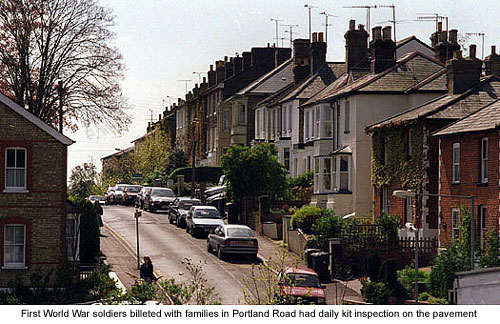 |
|
|
|
Near the bottom of Apton Road a section of Portland Road runs parallel with it, climbing back up the hill before turning sharply south towards Newtown Road. At its start an access leads to the rear of South Street’s shops, the land here now quite derelict and run-down and giving no indication it was the former site of Bishop’s Stortford’s Great Hall (See Guide 15).
Mr Tucker’s garden nursery in Apton Road also included land in Portland Road, the site now occupied by an independent church group founded here in 1999. The building they use was previously the local Salvation Army Citadel.
|
|
|
|
 |
|
|
|
Salvation Army
|
|
Members of the Salvation Army first arrived in Bishop’s Stortford in 1883, and held their first meeting on a Saturday afternoon in a place called the Grain Shed. Like other religious groups before them, Salvationists were not particularly welcome in the town, and on that day residents greeted them with a barrage of rotten eggs. For fourteen years all future meetings were held in the Great Hall (See Guide 15), but even there some members of the Working Men’s Club made it blatantly obvious they were still unwelcome. In fact, Salvationists throughout the country were persecuted for many years, one Bishop’s Stortford member being sent to prison in Cambridge for having the audacity to preach in the open air.
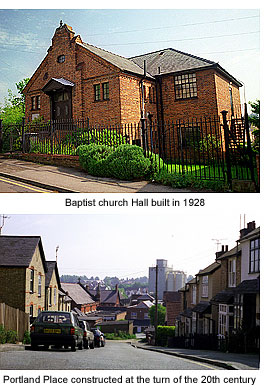 The Salvation Army was formed by William Booth, his sole objective in life being to minister to the physical as well as the spiritual needs of people. The emphasis was education of Christian belief and, in particular, the relief of social poverty. Born in Nottingham in 1829, Booth preached in the poorer quarters of London’s East End where he gained many converts, but his original aim to send them to established churches soon backfired. Regular churchgoers, appalled by their ‘shabby’ dress, pungent odours and poor status, did little to make them welcome. The Salvation Army was formed by William Booth, his sole objective in life being to minister to the physical as well as the spiritual needs of people. The emphasis was education of Christian belief and, in particular, the relief of social poverty. Born in Nottingham in 1829, Booth preached in the poorer quarters of London’s East End where he gained many converts, but his original aim to send them to established churches soon backfired. Regular churchgoers, appalled by their ‘shabby’ dress, pungent odours and poor status, did little to make them welcome.
Booth’s answer to this was to give them a church of their own and in 1865 formed the East London Christian Mission (later ‘The Christian Mission’). But with very little impetus to bring the public’s attention to his cause, the Mission was slow to catch on and made little positive impact.
Followers of Booth’s doctrine, both men and women, were known as ‘Volunteers’ but soon became the source of public ridicule when they were likened to the part-time soldiers who served in Queen Victoria’s forces. Undeterred, they felt compelled by an inner faith to carry on their work, but Booth became more and more frustrated. In a brief moment of anger and, as it turned out, inspiration, he struck out the name ‘Volunteer’ from a page of their literature and rewrote the word ‘Salvation’. The year was 1878 and the Salvation Army was born.
|
|
With a new identity the Army’s number grew rapidly. Members began calling themselves soldiers, or Booth’s lieutenants or captains, and Booth himself became known as the General. A uniform was introduced and a flag designed, inspiring a military spirit that soon engulfed the ‘ranks’ of this quasi-military organisation. Prayers became known as ‘knee-drill’ and the Army’s news sheet was renamed the War Cry.
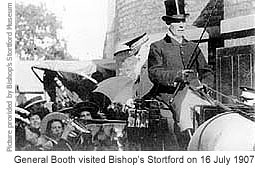 General Booth visited Bishop’s Stortford on Tuesday 16 July 1907, arriving at 3pm. No public reception was arranged, but a crowd of about 2,000 people assembled in North Street where the Salvation Army band played outside the Urban District Council offices and gave him a vociferous welcome. He then held a public meeting in the Congregational Chapel, Water Lane, which had been placed at his disposal. There he was welcomed by various vicars of the community and spoke for about an hour on the lessons of his life and his work in the Army in different parts of the world. Afterwards he resumed his journey via Newport and Saffron Walden to Cambridge. General Booth visited Bishop’s Stortford on Tuesday 16 July 1907, arriving at 3pm. No public reception was arranged, but a crowd of about 2,000 people assembled in North Street where the Salvation Army band played outside the Urban District Council offices and gave him a vociferous welcome. He then held a public meeting in the Congregational Chapel, Water Lane, which had been placed at his disposal. There he was welcomed by various vicars of the community and spoke for about an hour on the lessons of his life and his work in the Army in different parts of the world. Afterwards he resumed his journey via Newport and Saffron Walden to Cambridge.
General Booth died in 1912, and the following year his grandson, Bernard Booth, was stationed in the town. At that time, meetings were held in a hall in Apton Road but when the Urban District Council condemned the building in 1925, new headquarters were constructed on this site at a cost of £1,395. The hall was first lit by electricity in 1938 and licenced for marriages in 1944.
Membership in Stortford remained stable for many years, but by 1998 had fallen to an all time low of just five people. No longer able to sustain the cost of running their building, the Salvation Army finally moved out in 1999 after being resident on the site for 74 years. Meetings have since been held in the Markwell Pavilion at Castle Gardens (See Guide 8). Although distinctive in its government and practice (which does not include the sacraments) the Salvation Army still remains an integral part of the Christian Church.
|
|
|
|
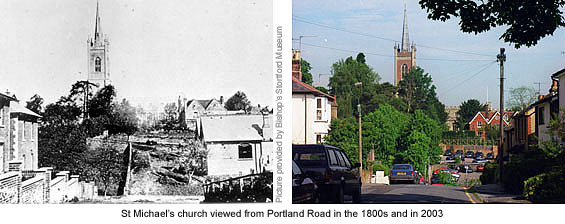 |
|
|
|
Portland Road (continued)
|
|
Portland Road now turns sharply left, the modern residential property Dorset House standing on land originally owned by the Great Hall but sold off in 1906 for housing development to raise funds. Opposite, on the west side of the road, two red-bricked semi-detatched houses – Nos 2&4 and 6&8 – still retain original ‘firemarks’ high on their front wall (See Guides 3 & 15).
When built in the mid 1800s most of the three-storey properties on this side of the road, hen overlooking a field and the gardens of private houses in South Street, were owned by more affluent members of the community. There size is such that in the late 19th and early 20th century, two of the houses were used as schools – the Collegiate School and the High School for Girls – and during World War I, soldiers were billeted with families here. The Baptist Church Hall was built in 1928 as a replacement for the small schoolhouse in Chapel Row.
Beyond is Portland Place. In 1867, the Taylor family (possibly Joseph and William Taylor who ran a malt-factor business), bought approximately one acre of land here. Their intention for use of the site is unknown, but in 1870 they sold the land to a town solicitor named William Gee. His purchase would seem to have been purely speculative, because eight years later he began selling off plots of the land to local people. This may have been for building purposes but no houses were actually built here until the turn of the 20th century. It's interesting to note that land ownership at that time wasn't quite the money-making business it has become today. The plot of land now housing Nos 2 and 4 Portland Place was sold in 1878 for £160. Twelve years later the same plot was re-sold for exactly the same amount.
Between 1876 and 1884, the western corner of Portland Road at its junction with Newtown Road was occupied by the Cricketers Arms public house (See New Town). After the pub closed it became an off-licence then, later, a boys school run by Dr Flood. When he moved out in the 1890s the property remained vacant until 1900 when it was then bought, along with an adjoining yard, by Father Oliver Vassall-Phillips.
He had arrived here that same year with instructions from the Catholic Church to find suitable premises in which to start a small monastery and church. This site wasn't large enough to fulfill the task, but the house did serve as a makeshift monastery and the adjoining yard proved ideal for the erection of a temporary church made of corrugated steel. Newtowner's immediately nicknamed it the 'Tin Tabernacle, but it gave Stortford's Catholics their first place of worship since the protestant Queen Elizabeth ascended to the throne in 1558, and served the community until 1906 when a new church was built at Windhill (See Guide 4 – St Joseph's Church). The temporary church was then dismantled and the adjoining property reverted back to private ownership, but in August 1936 a fire took hold while the owner was away and the building was completely destroyed. The site is now that of a modern apartment block and small business.
|
|
|
|
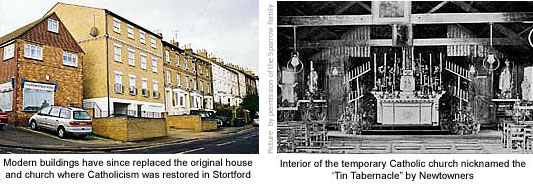 |
|
|
|
[ BACK TO TOP ] |
|
|
|
|
|
|
|
|
|








 Opposite is St Michael’s Junior School, built in the 1950s and taking its name from the original St Michael's school erected in 1818. Part of that school, rebuilt and extended in 1832, now forms the Apton Road Day Centre.
Opposite is St Michael’s Junior School, built in the 1950s and taking its name from the original St Michael's school erected in 1818. Part of that school, rebuilt and extended in 1832, now forms the Apton Road Day Centre. The Salvation Army was formed by William Booth, his sole objective in life being to minister to the physical as well as the spiritual needs of people. The emphasis was education of Christian belief and, in particular, the relief of social poverty. Born in Nottingham in 1829, Booth preached in the poorer quarters of London’s East End where he gained many converts, but his original aim to send them to established churches soon backfired. Regular churchgoers, appalled by their ‘shabby’ dress, pungent odours and poor status, did little to make them welcome.
The Salvation Army was formed by William Booth, his sole objective in life being to minister to the physical as well as the spiritual needs of people. The emphasis was education of Christian belief and, in particular, the relief of social poverty. Born in Nottingham in 1829, Booth preached in the poorer quarters of London’s East End where he gained many converts, but his original aim to send them to established churches soon backfired. Regular churchgoers, appalled by their ‘shabby’ dress, pungent odours and poor status, did little to make them welcome. General Booth visited Bishop’s Stortford on Tuesday 16 July 1907, arriving at 3pm. No public reception was arranged, but a crowd of about 2,000 people assembled in North Street where the Salvation Army band played outside the Urban District Council offices and gave him a vociferous welcome. He then held a public meeting in the Congregational Chapel, Water Lane, which had been placed at his disposal. There he was welcomed by various vicars of the community and spoke for about an hour on the lessons of his life and his work in the Army in different parts of the world. Afterwards he resumed his journey via Newport and Saffron Walden to Cambridge.
General Booth visited Bishop’s Stortford on Tuesday 16 July 1907, arriving at 3pm. No public reception was arranged, but a crowd of about 2,000 people assembled in North Street where the Salvation Army band played outside the Urban District Council offices and gave him a vociferous welcome. He then held a public meeting in the Congregational Chapel, Water Lane, which had been placed at his disposal. There he was welcomed by various vicars of the community and spoke for about an hour on the lessons of his life and his work in the Army in different parts of the world. Afterwards he resumed his journey via Newport and Saffron Walden to Cambridge.